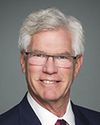When it comes to the gun violence the city's experiencing, I can tell you that we are seeing more guns being fired and the discharge of firearms in public spaces, not in people's homes and not in confined spaces. It's difficult to draw a clear line between what is a gang shooting and what is a shooting that's drug related or related to protection of turf or illicit business. We know we have a serious issue with respect to the proliferation of firearms among persons who are not readily known to be gang members or associated to gangs.
[Technical difficulty—Editor] more and more shootings and more and more firearms recovered from persons who are not necessarily directly related to gangs, as we identify gangs or have the intelligence to identify them. That speaks to one of the intelligence challenges we face—the ability to understand precisely who is legally to be identified as being in a gang. We know that the proliferation of guns is becoming more widespread, and we see from our demographics as it relates to age, that the age is dropping significantly. We've recently had shootings involving extremely young people. It's a very concerning trend.
As far as how many are domestic violence, I don't have it broken down that way, but I can tell you that the predominant problems are shootings out on the street between rivals or persons with no apparent connection to one another.





